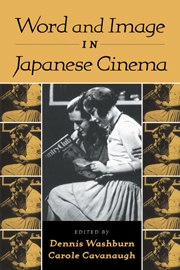Book contents
- Frontmatter
- Contents
- List of Illustrations
- Contributors
- Foreword: Outside Views of the Japanese Film
- Introduction
- PART ONE WORDING THE IMAGE/IMAGING THE WORD
- PART TWO REFLECTIONS OF IDENTITY
- 7 Where's Mama? The Sobbing Yakuza of Hasegawa Shin
- 8 Saving the Children: Films by the Most “Casual” of Directors, Shimizu Hiroshi
- 9 Ishihara Yûjirô: Youth, Celebrity, and the Male Body in late-1950s Japan
- 10 Otoko wa tsurai yo: Nostalgia or Parodic Realism?
- 11 A Working Ideology for Hiroshima: Imamura Shôhei's Black Rain
- PART THREE OUTSIDE THE FRAME OF CULTURE
- Selected Bibliography of Articles and Books in English
- Index
7 - Where's Mama? The Sobbing Yakuza of Hasegawa Shin
Published online by Cambridge University Press: 01 March 2010
- Frontmatter
- Contents
- List of Illustrations
- Contributors
- Foreword: Outside Views of the Japanese Film
- Introduction
- PART ONE WORDING THE IMAGE/IMAGING THE WORD
- PART TWO REFLECTIONS OF IDENTITY
- 7 Where's Mama? The Sobbing Yakuza of Hasegawa Shin
- 8 Saving the Children: Films by the Most “Casual” of Directors, Shimizu Hiroshi
- 9 Ishihara Yûjirô: Youth, Celebrity, and the Male Body in late-1950s Japan
- 10 Otoko wa tsurai yo: Nostalgia or Parodic Realism?
- 11 A Working Ideology for Hiroshima: Imamura Shôhei's Black Rain
- PART THREE OUTSIDE THE FRAME OF CULTURE
- Selected Bibliography of Articles and Books in English
- Index
Summary
In the end, Chûtarô of Banba gets what we all want – Chûtarô of Banba gets his girl. For anyone from a psychoanalytically informed culture, Chûtarô's getting of his girl is a queasy scene to watch, for the girl Chûtarô gets is the girl we all don't know that we really want.
In the final shot of Inagaki Hiroshi's 1931 film Mother Under the Eyelids (Mabuta no haha), mother and son embrace in a mist of tears and collapse to the ground, each folded into the other, a secure ball protected from the world. It has taken Chûtarô thirty years of destitution, wandering, and battles to reach the mother who abandoned him when he was five. In those years his losses have been great: he has forgone romance, conjugal love, and progeny, and has never settled down. In the course of the movie he travels to Edo looking for his mother, defending weak women and mistaking them for the real thing. To each he gives change from the purse he carries, as if purchasing their sympathy and paying down for the final product. The end of Chûtarô's longing demands the final sacrifice of his development as a man. In his end he returns to his beginning. Chûtarô has no choice but to return home to his mother, for he embodies his home and his name is inscribed on his identity. He is Chûtarô of Banba.
- Type
- Chapter
- Information
- Word and Image in Japanese Cinema , pp. 149 - 173Publisher: Cambridge University PressPrint publication year: 2000
- 1
- Cited by

